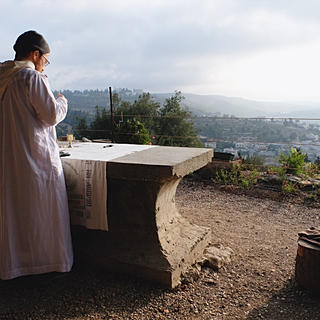To the Byzantine Roots of Worship
- Beatitudes Missions
- Oct 6, 2018
- 4 min read
Updated: Aug 21, 2019
Welcome back to our Fall Immersion Blog! We drove on towards the rising sun, preparing to fly further, over the Ocean and Mediterranean, for our three-month experience of the Middle East. Anticipating this encounter, we tried our hand at making hummus and minted Greek yogurt, we've learned some folk dances, and we've even learned to celebrate the Eucharist according to one of the many ancient Eastern Rites.

Fr. Anthony is a "bi-ritual" priest of the Byzantine Rite. He has taught us to serve and chant for the Byzantine Mass, or "Divine Liturgy," and we've been able to offer this celebration to college students at six different campuses. We had so many students attend these events, often saying that they had heard a lot about Byzantine prayer and Eucharist, seen many icons, maybe even been inside an Eastern church, but they usually had never actually attended. Several others said they identified themselves as Byzantine, or part of their family did, and they were excited to have a celebration right on campus--now their friends would be able to see what they'd been trying to tell them about!
What exactly does "Byzantine" mean? This is the most developed and most widely-used Rite among Eastern Christians, and it also refers to the culture, Theology, and spirituality of Christians originating in 4th-century Constantinople. Today, it includes most of Greece, Turkey, Bulgaria, Romania, Ukraine, Russia, Cyprus, and the Holy Land, as well as significant parts of Slovakia, Hungary, and Lebanon, not to mention the Byzantine diaspora of those nationalities all over the world.
The split between Roman and Eastern Catholicism occurred through several stages, but many refer to 1054 as the year of a definitive separation, delineated by the Western and Eastern sides of Christendom. Most Byzantines are Orthodox (these do not recognize the Pope), but there is a significant minority of Byzantine Catholics (also called Greek Catholics).
Our current Roman Rite was reformed from the Byzantine Rite, however the Byzantine Catholic Mass is quite different than the traditional Roman Rite Mass. At first glance, one notices the icon screen, dividing the sanctuary from the nave--we simplified this, just setting up the icons of Jesus and Mary to create the "Royal Doors", which only the priest to passes through. This symbolizes Christ entering into the Holy of Holies of the world, of humanity, and of the Temple that we form. In the center is the icon of the day, which the faithful kiss as they enter and exit the church, similar to the way Roman Catholics sign themselves with Holy Water. Before the Liturgy begins, the priest prepares the bread and wine before an icon of the Incarnation. It is a loaf of leavened bread, called the "Lamb", stamped with the letters, "IC XP NIKA" (Jesus Christ Conquers). He also divides the bread before the Liturgy to commemorate saints and prayer intentions.

During the Liturgy of the Word, the faithful all stand for the entire Liturgy except the homily. Most of the Liturgy is chanted, creating an prayerful and enticing environment. At the time the Gospel is read, the faithful can approach near the sanctuary, and after the reading the priest invites the faithful to venerate Christ by kissing the Book of the Gospels. And to conclude, Communion in the Byzantine Mass is also quite different. The priest pours hot water into the Blood, signifying the Holy Spirit, then he puts all the morsels of the Body into the cup. He uses a spoon to drop the Lord into your mouth, as he prays a prayer that includes your name.
We had briefly visited The Ukrainian Byzantine Church in Denver earlier in our pilgrimage, and the priest told us, "The Byzantine tradition shows you, not just tells you." It was a beautiful experience becoming more familiar with this form of Mass, and to educate other students as well. We can't wait to celebrate in Byzantine churches of the Holy Land! Here's some feedback we received from the students:
"The Divine Liturgy makes me more aware of all the angels continuously celebrating Liturgy in heaven, and we are simply joining!"
"The continuous song and prayer throughout the Mass was incredibly beautiful. It allowed me to meditate deeper into the Divine Liturgy and feel totally renewed by the Holy Spirit."
"By warming the water receieved in the Eucharist, it became a visceral reminder of the flesh and blood of Christ. It made communion so much more intimate and it felt so genuine!"
Postscript: We appreciate all of your prayers. We safely made it to Emmaus, which included a day-long layover in Rome! Thank you to all of our benefactors and for all of the prayers. We created an Instagram for our Missions, so be sure to give @BeatitudesMissions a follow!
The first month of our Fall Immersion has come to an end. It has been an adventurous, spirit filled journey! Visiting the college campuses has been such a blessing. We encountered lots of eager students wanting to give time to the Lord through Beatitudes Missions, as well as teaching lots of Israeli dancing sessions, and even held several Divine Liturgy Masses. We are incredibly humbled and blessed by our hosts, and all who helped us in the United States mission. We visited altogether University of Nebraska-Kearney and Lincoln, University of Kansas, Kansas State University, Benedictine University, Northwest Missouri State, Emporia State, University of Iowa, Minnesota State-Mankato, University of Wisconsin-La Crosse and University of Wisconsin-Madison, Grand Valley University, Notre Dame, and Bowling Green State University.
Until next time!


























Comments